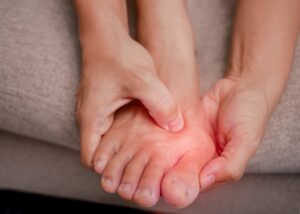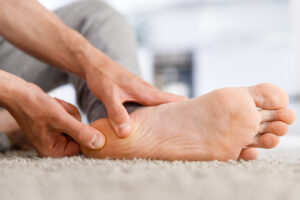If you’ve ever noticed a bonyFacts About Bunions bump forming at the base of your big toe, you may be dealing with a bunion. While many dismiss bunions as “just cosmetic,” they can cause real pain, affect your balance, and even change the way you walk.
At their core, bunions are a progressive foot deformity, which means they usually get worse over time. The good news? With today’s advanced treatments, including minimally invasive bunion surgery, you don’t have to live with the discomfort.
 Here are 10 surprising facts about bunions you may not know, plus the best ways to treat them.
Here are 10 surprising facts about bunions you may not know, plus the best ways to treat them.
- Bunions Aren’t Just Cosmetic
That bump on the side of your foot isn’t just about appearance — it’s a sign your bones are shifting out of place. As the joint drifts, it can cause instability, stiffness, and eventually arthritis if ignored. This is why bunions aren’t just about “how your foot looks.” They’re about how well your foot works. Catching them early means you can avoid years of pain and joint damage. - Bunions Can Affect Any Age — Even Teenagers
While many people associate bunions with older adults, they can appear at any age. Teens and young adults sometimes develop bunions because of inherited foot shapes, flat feet, or even athletic footwear that isn’t supportive. If bunions run in your family, pay attention to early warning signs like toe drifting or pain in tight shoes. Early care can slow progression. - High Heels Aren’t the Only Culprit
High heels get the blame, but they’re not the only issue. Any shoe that squeezes your toes or lacks arch support, even flats or running shoes, can worsen bunions. Over time, poor footwear forces your big toe inward, fueling the problem. Choosing supportive shoes with room for your toes to spread is one of the simplest ways to protect your feet. - Bunions Can Be Linked to Other Health Issues
Sometimes a bunion is more than just a foot problem. Conditions like arthritis, gout, or neuromuscular disorders can contribute to bunion formation. If you notice one developing, don’t shrug it off; it could be a clue about your overall health. A foot and ankle specialist can determine if a bunion is part of a bigger issue. - Bunions Have Been Around for Thousands of Years
Archaeologists have found bunions in ancient Egyptian mummies, proving this isn’t just a “modern shoe problem.” The difference today? We have advanced, minimally invasive treatments that our ancestors didn’t have. You don’t have to live with the same pain and deformity that plagued people for centuries. - Bunions Get Worse If You Ignore Them
A bunion is progressive, which means it only goes in one direction: worse. The bump grows larger, pain increases, and your other toes may start shifting too, causing hammertoes or corns. Ignoring bunions can eventually lead to arthritis in your big toe joint, making even simple steps painful. The earlier you act, the easier they are to treat. - Non-Surgical Care Helps, But Won’t “Fix” a Bunion
Shoes with a wide toe box, orthotics, padding, and even physical therapy can all make life with bunions more comfortable. They reduce pain and slow progression, but they won’t make the bump disappear. Only surgery can truly correct a bunion. That said, non-surgical care is often an excellent first step, especially for mild bunions or patients not ready for surgery. - Modern Bunion Surgery Isn’t What You Think
If you’ve heard bunion surgery horror stories, you’re not alone — but those are outdated. Today’s minimally invasive bunion correction uses small incisions, leads to faster healing, and often lets you walk the same day in a boot. Instead of months of downtime, recovery is often just a few weeks. For patients struggling with daily pain, this is a life-changing difference. - You Don’t Have to Wait Until It’s “Bad Enough”
Many patients put off bunion treatment until they can barely walk or fit into shoes. But waiting only makes surgery more complex and recovery longer. The best results come from addressing bunions early — when symptoms first appear. Think of it like fixing a small leak before it floods the whole house. - The Right Specialist Makes All the Difference
Not every doctor approaches bunions the same way. The key is finding a specialist who understands the latest treatment options, from conservative care to minimally invasive surgery, and can match the right approach to your specific needs. The right expertise means better results, less downtime, and long-term relief.
Best Ways to Treat Bunions
While bunions don’t go away on their own, there are many ways to manage symptoms and slow their progression. Treatment depends on the severity of your bunion and how much it impacts your daily life.
Non-Surgical Treatments for Bunions
- Supportive footwear: Wide toe box, cushioning, firm arch support.
- Custom orthotics: Redistribute pressure and improve alignment.
- Padding and taping: Reduce irritation and provide temporary toe support.
- Anti-inflammatory care: Ice packs and OTC medications for pain/swelling.
- Stretching & physical therapy: Strengthen surrounding muscles for stability.
These approaches can ease pain and make walking more comfortable, but they don’t correct the bunion itself.
Advanced & Surgical Treatments
When bunions interfere with walking, shoe wear, or daily comfort, surgery may be the best option.
- Minimally Invasive Bunion Surgery – Small incisions, faster recovery, often allows same-day walking in a boot.
- Bunion Correction Surgery – Realigns the bones, corrects deformity, and restores natural function.
- Personalized Treatment Plans – Surgical options are tailored to each patient’s bunion severity, activity level, and lifestyle for the best long-term outcome.
Why Early Treatment Matters
Delaying care only lets bunions progress, and once the joint begins to shift, the deformity rarely stops on its own. Early treatment matters because:
- Progression is gradual but inevitable. Bunions are a progressive condition. The bump becomes larger over time, the big toe drifts further inward, and the surrounding toes can become crowded or bent.
- Complications multiply with time. Untreated bunions can lead to hammertoes, corns, calluses, chronic inflammation, and even arthritis in the big toe joint. These secondary problems can cause more pain than the bunion itself.
- Shoe options become more limited. As bunions enlarge, finding comfortable footwear becomes increasingly difficult. Patients often report giving up certain shoes or activities because of discomfort.
- The joint becomes harder to correct. Smaller, early bunions can sometimes be managed with conservative care, or if surgery is needed, it’s typically less complex. Delaying care often means the deformity becomes more severe, requiring more extensive correction.
- Recovery is smoother with earlier intervention. Patients who address bunions before they cause major damage often experience shorter recovery times and return to normal activity sooner than those who wait until pain is severe.
In short, early evaluation doesn’t always mean you’ll need surgery, but it does mean you’ll get a clear plan to manage the condition and protect your long-term foot health.

Bunions don’t just change how your foot looks; they change how you live. They can make walking painful, exercising frustrating, and even wearing your favorite shoes impossible. But the good news is, you don’t have to live with bunion pain forever.
With today’s advanced treatments, including minimally invasive bunion correction, it’s possible to ease discomfort, correct the deformity, and restore natural movement, often with faster recovery than ever before.
That’s where Dr. Robert J. Joseph makes the difference. Known for his expertise in bunions and complex foot conditions, he combines precise diagnostics, innovative surgical techniques, and personalized treatment plans to deliver lasting relief. His goal isn’t just to remove the bump — it’s to restore comfort, confidence, and strength in every step.
Don’t wait for bunions to get worse. Schedule your consultation with Dr. Joseph today and take the first step toward pain-free movement and healthier feet for the future.










